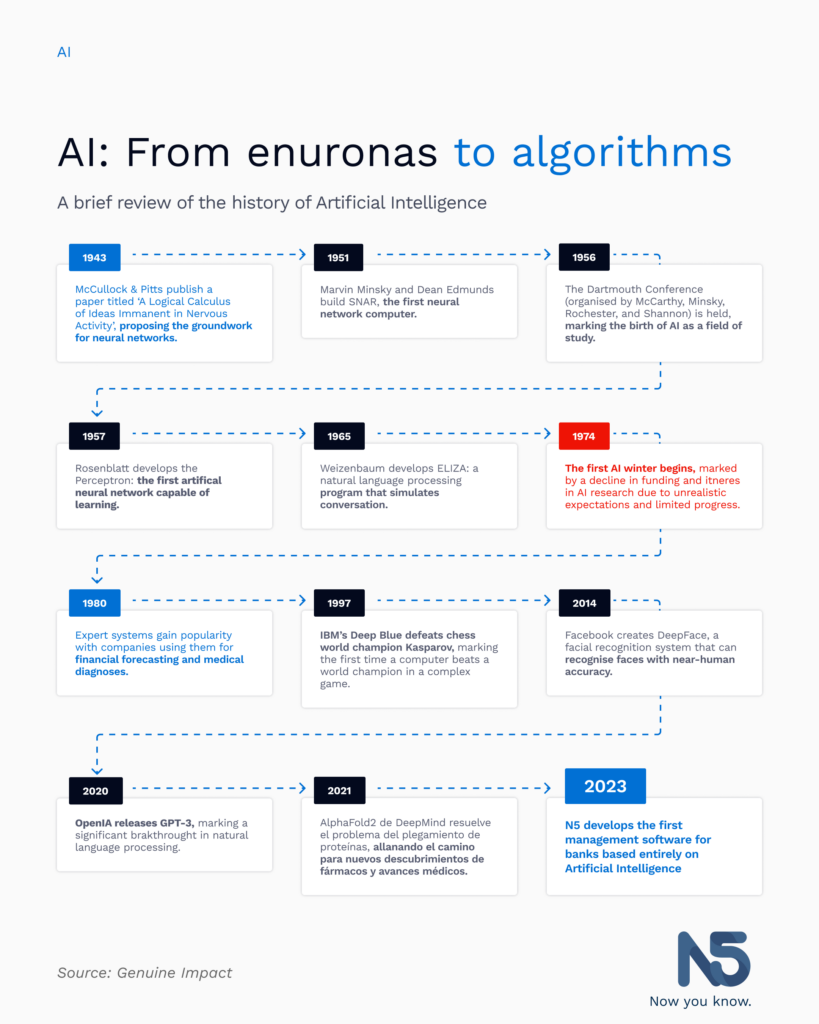
The advancement of artificial intelligence has been a fascinating journey over the years. From the foundations of neural networks in the 1940s to more recent developments in natural language processing and deep learning, AI has transformed the way we interact with technology and opened up new possibilities in many fields. Below, we’ll explore some key milestones in the history of artificial intelligence, which have laid the foundation for the development of intelligent systems and led to amazing advances in recent years.
1945: McCullock and Pitts laid the foundation for neural networks, a technique that mimics how the human brain works to recognize patterns and make predictions through artificial connections of neurons.
1950: Alan Turing proposed the Turing Test, a test to assess a machine’s ability to exhibit human-like intelligent behavior in natural language conversation.
1951: Marvin Minsky and Dean Edmunds built SNAR, the first neural network computer, which laid the foundation for future advances in this field.
1956: The Dartmouth Conference marked the birth of artificial intelligence as a field of study, bringing together experts in the field and laying the theoretical and practical foundations of AI.
1957: Frank Rosenblatt developed the Perceptron, the first artificial neural network capable of learning and adapting.
1965: Joseph Weizenbaum developed ELIZA, a natural language processing program that simulated a conversation and laid the foundation for future advances in human-machine interaction.
1967: Allen Newell and Herbert Simon developed the General Problem Solver (GPS), one of the first artificial intelligence programs that demonstrated the ability to solve problems in a similar way to humans.
1974: AI experienced its first winter, a time of declining research funding and interest due to unrealistic expectations and limited progress.
1980s: Expert systems became popular in companies, used for financial forecasting and medical diagnostics, providing early insight into how AI could benefit different industries.
1986: Geoff Hinton, David Rumelhart and Ronald Williams published ‘Learning Representations by Back Propagating Errors’, a breakthrough in training deeper neural networks.
1997: IBM’s Deep Blue artificial intelligence program defeated world chess champion Garry Kasparov, marking a major milestone in the machines’ ability to compete in complex games.
2002: iRobot introduced Roomba, the first mass-produced home robot vacuum with an AI-powered navigation system, showing how AI could enhance home automation.
2011: IBM’s Watson defeated two previous champions of the quiz show Jeopardy!, demonstrating the power of AI in natural language processing and information search.
2012: Leading artificial intelligence startup DeepMind reached a significant milestone by developing a deep neural network capable of recognizing and classifying images, including the ability to identify cats in YouTube videos. This innovation marked a major advance in the field of computer vision and laid the foundation for future developments in image recognition and visual processing.
2014: Facebook shocked the world with the launch of DeepFace, a highly accurate facial recognition system that can recognize faces with near-human precision. This revolutionary technology has had a significant impact on security, authentication, and user experience across various applications and platforms.
2015: DeepMind’s development of AlphaGo captured worldwide attention when it defeated world Go champion Lee Sedol. This achievement demonstrated how artificial intelligence could outperform human experts in complex and strategic games, pushing the limits of what was thought possible in terms of learning and decision-making capabilities.
2017: Google surprised yet again with the release of AlphaZero, an AI system that defeated the world’s best chess and shogi engines in a series of games. This achievement highlighted the ability of artificial intelligence to dominate strategic games and provided new perspectives on how AI could be applied in other fields, such as planning and complex decision-making.
2020: OpenAI made history with the release of GPT-3, an advanced natural language model that marked a significant advance in natural language processing. GPT-3 demonstrated amazingly accurate text comprehension and generation, opening up new possibilities in areas such as machine translation, content generation and virtual assistance.
2021: DeepMind again rose to prominence with the development of AlphaFold2, a revolutionary system that solved the challenging problem of protein folding. This advance has a far-reaching impact on medical and pharmaceutical research, as it allows for a better understanding of protein structures and accelerates the discovery of new drugs and therapies.
2022: Renowned Google engineer Blake Lemoine caused a stir by discussing the capabilities of Google’s Language Model for Dialog Applications (LaMDA). Lemoine highlighted how LaMDA has reached amazing levels of intelligence and contextual understanding, taking AI to a new level of conversation and support in various applications.
2023: In an exciting breakthrough for the financial industry, N5 has developed the first fully Artificial Intelligence-based banking management software. This innovation has revolutionized the way banks operate, streamlining processes, improving efficiencies and delivering an exceptional customer experience. With the addition of AI, N5 has created an intelligent solution that automates complex tasks, provides real-time data analysis and ensures greater security in financial transactions. This advancement marks an important milestone in the digital transformation of the banking industry, enabling more efficient asset management, improved personalization of services, and more informed decision-making. N5’s software represents a new era of artificial intelligence applied to banking, paving the way for further automation, optimization and customer experience improvements.

